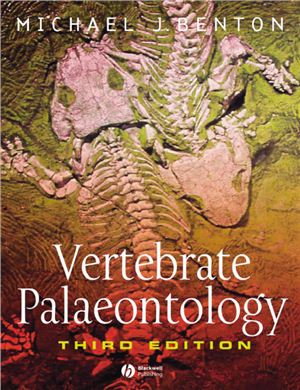© 2005 Blackwell Science Ltd.
Vertebrate origin.
sea squirts and the lancelet.
Phylum Hemichordata: pterobranchs and aco worms.
Deuterostome relationships.
Chordate origins.
Vertebrates and the head.
Further reading.
How to study fossil vertebrates.
digging up bones.
Geology and fossil vertebrates.
Biology and fossil vertebrates.
Discovering phylogeny.
The quality of the fossil record.
Further reading.
Early palaeozoic fishes.
cambrian vertebrates.
Vertebrate hard tissues.
The jawless fishes.
Origin of jaws and gnathostome relationships.
Placodermi: armour-plated monsters.
Chondrichthyes: the first sharks.
Acanthodii: the ‘spiny skins’.
Devonian environments.
Osteichthyes: the bony fishes.
Early fish evolution and mass extinction.
Further reading.
The early tetrapods and amphibians.
problems of life on land.
Devonian tetrapods.
The Carboniferous world.
Diversity of Carboniferous tetrapods.
Temnospondyls and reptiliomorphs after the Carboniferous.
Evolution of mode amphibians.
Further reading.
The evolution of early amniotes.
hylonomus and Paleothyris—biology of the first amniotes.
Amniote evolution.
The Permian world.
The early evolution of anapsids and diapsids.
Basal synapsid evolution.
Mass extinction.
Further reading.
Tetrapods of the triassic.
the Triassic scene.
Evolution of the archosauromorphs.
In Triassic seas.
The origin of the dinosaurs.
Further reading.
The evolution of fishes after the devonian.
the early sharks and chimaeras.
Post-Palaeozoic chondrichthyan radiation.
The early bony fishes.
Radiation of the teleosts.
Post-Devonian evolution of fishes.
Further reading.
The age of dinosaurs.
biology of Plateosaurus.
The Jurassic and Cretaceous world.
The diversity of saurischian dinosaurs.
The diversity of oithischian dinosaurs.
Were the dinosaurs warm-blooded or not?
Pterosauria.
Testudines: the turtles.
Crocodylia.
Lepidosauria.
The great sea dragons.
Diversification of Jurassic–Cretaceous reptiles.
The Kt event.
Further reading.
The birds.
archaeopteryx.
The origin of bird flight.
Cretaceous birds,with and without teeth.
The radiation of mode birds.
Flightless birds: Palaeognathae.
Neognathae.
Diversification of birds.
Further reading.
The mammals.
cynodonts and the acquisition of mammalian characters.
The first mammals.
The Mesozoic mammals.
The marsupials.
South American mammals—a world apart.
Afrotheria and break-up of Gondwana.
The beginning of the age of placental mammals.
Basal Laurasiatherians: insectivores and bats.
Cetartiodactyla: cattle, pigs and whales.
Perissodactyla: grazers and browsers.
Caivora and Pholidota.
Archonta: primates, tree shrews and flying lemurs.
Glires: rodents, rabbits and relatives.
Ice Age extinction of large mammals.
The patte of mammalian evolution.
Further reading.
Human evolution.
what are the primates?
The early fossil record of primates.
Hominoidea: the apes.
Evolution of human characteristics.
The early stages of human evolution.
The past two million years of human evolution.
Further reading.
Appendix: Classification of the vertebrates.
glossary.
references.
index.
Vertebrate origin.
sea squirts and the lancelet.
Phylum Hemichordata: pterobranchs and aco worms.
Deuterostome relationships.
Chordate origins.
Vertebrates and the head.
Further reading.
How to study fossil vertebrates.
digging up bones.
Geology and fossil vertebrates.
Biology and fossil vertebrates.
Discovering phylogeny.
The quality of the fossil record.
Further reading.
Early palaeozoic fishes.
cambrian vertebrates.
Vertebrate hard tissues.
The jawless fishes.
Origin of jaws and gnathostome relationships.
Placodermi: armour-plated monsters.
Chondrichthyes: the first sharks.
Acanthodii: the ‘spiny skins’.
Devonian environments.
Osteichthyes: the bony fishes.
Early fish evolution and mass extinction.
Further reading.
The early tetrapods and amphibians.
problems of life on land.
Devonian tetrapods.
The Carboniferous world.
Diversity of Carboniferous tetrapods.
Temnospondyls and reptiliomorphs after the Carboniferous.
Evolution of mode amphibians.
Further reading.
The evolution of early amniotes.
hylonomus and Paleothyris—biology of the first amniotes.
Amniote evolution.
The Permian world.
The early evolution of anapsids and diapsids.
Basal synapsid evolution.
Mass extinction.
Further reading.
Tetrapods of the triassic.
the Triassic scene.
Evolution of the archosauromorphs.
In Triassic seas.
The origin of the dinosaurs.
Further reading.
The evolution of fishes after the devonian.
the early sharks and chimaeras.
Post-Palaeozoic chondrichthyan radiation.
The early bony fishes.
Radiation of the teleosts.
Post-Devonian evolution of fishes.
Further reading.
The age of dinosaurs.
biology of Plateosaurus.
The Jurassic and Cretaceous world.
The diversity of saurischian dinosaurs.
The diversity of oithischian dinosaurs.
Were the dinosaurs warm-blooded or not?
Pterosauria.
Testudines: the turtles.
Crocodylia.
Lepidosauria.
The great sea dragons.
Diversification of Jurassic–Cretaceous reptiles.
The Kt event.
Further reading.
The birds.
archaeopteryx.
The origin of bird flight.
Cretaceous birds,with and without teeth.
The radiation of mode birds.
Flightless birds: Palaeognathae.
Neognathae.
Diversification of birds.
Further reading.
The mammals.
cynodonts and the acquisition of mammalian characters.
The first mammals.
The Mesozoic mammals.
The marsupials.
South American mammals—a world apart.
Afrotheria and break-up of Gondwana.
The beginning of the age of placental mammals.
Basal Laurasiatherians: insectivores and bats.
Cetartiodactyla: cattle, pigs and whales.
Perissodactyla: grazers and browsers.
Caivora and Pholidota.
Archonta: primates, tree shrews and flying lemurs.
Glires: rodents, rabbits and relatives.
Ice Age extinction of large mammals.
The patte of mammalian evolution.
Further reading.
Human evolution.
what are the primates?
The early fossil record of primates.
Hominoidea: the apes.
Evolution of human characteristics.
The early stages of human evolution.
The past two million years of human evolution.
Further reading.
Appendix: Classification of the vertebrates.
glossary.
references.
index.

